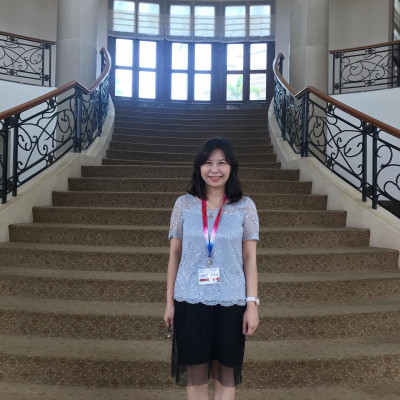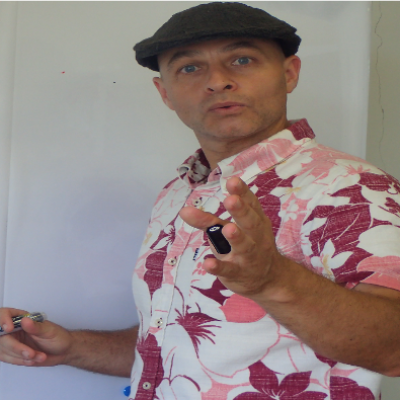Sessions / Location Name: Zoom E
Virtual Location
Virtual: You cannot enter virtually via this page. Click on the titles of individual presentations or go to the Live Page
Playful coding tasks: computational thinking makes its way to the language classroom #3092
Computational thinking and coding have become part of the educational curriculum in many schools. But what about learning to code in English? Definitely possible! In this session I will be discussing the difference between computational thinking and coding and their place in the language classroom, in line with problem-based methodologies. The session will continue with basic concepts that can be introduced with young learners (8 year-olds onwards), and practical examples of playful and game-like tasks that learners can carry out using the free online coding programme 'Scratch' and the 'Micro:bit' programmable card. The features of these programming options will be shown, and the tasks showcased will be sequenced in order of complexity, according to the coding concepts involved.
The initial tasks on 'Scratch' will include animating text and characters, in order to create simple visuals and then stories, and coding simple games and musical sequences. As the learners gradually acquire coding skills, the next set of tasks will be using the Micro:bit card to code objects for application projects, like a dice, a sound warning, a poll and a moisture sensor. As we showcase each task, we will dive into the code itself as much as possible.
By the end of the session, participants will have become familiar with coding options that can easily be used in the classroom, ways of making coding relevant for language learning, and meaningful task ideas and samples of students’ work.
Effects of metacognitive instruction and online game-based learning on promoting EFL listening ability #3035
This study attempts to investigate the effect of the blended learning mode involved in metacognitive instruction and online game-based learning on promoting EFL students' listening ability. Fifty EFL students in a five-year junior college in Taiwan are included in this teaching practices within an eight-week training. The first four weeks, students underwent a series of metacognitive strategies enhanced instruction, entailing self-regulated listening practices, listening buddies, and metacognitive strategies instruction in class. The second four weeks, students were provided with the online game-based learning platform, designed by the instructor and a group of educational-technology-major university students. The online game serves as a self-pace learning tool, containing four parts: vocabulary builder, two different vocabulary games and a listening comprehension test. Students could review the vocabulary with their own pace and fulfill the games and listening test subsequently. By implementing online games, we expect to investigate the perpetuated effect on games with metacognitive instruction on ESL ‘s listening comprehension. The result showed the significant gains from pre- to post- to delayed post tests on students' listening comprehension, indicating the series of metacognitive listening instruction had positive effect on students’ listening ability, with online games amplified the effect. Metacognitive Awareness Listening Questionnaire (MALQ), composing of five areas of metacognitive awareness: problem solving, planning and evaluation, mental translation, directed attention, and person knowledge, showed the similar effect from pre to post MALQ among these five areas. However, students delay MALQ had significant different effect in terms of “directed attention” area, pinpointing the importance of online games. Qualitatively, students’ listening reflected diary signaled the significance of the awareness of listening context and key words as well as the exposure to online game-based practices.
Ready, set…? End-user testing of an AR treasure hunt learning game #3070
This presentation describes testing of “KSU Treasure Hunter”, a campus guide smartphone app designed and developed by the researchers. The app presents practical information about campus services in a bilingual, pirate treasure hunt-themed Augmented Reality learning game. Testing was designed to fill a gap in research that balances concerns with both learning, including game design, in-game experience and behaviors, and pedagogy, specifically in-game pedagogical features. It involved the collection of anecdotal evidence from surveys and interviews, and descriptive evidence from observations of the behavior of testers from three distinct groups: students, instructors, and stakeholders. The survey asked testers to rate learning, engagement, and usability. Survey data showed that testers (N=21) rated learning significantly higher than both engagement (p<0.01) and usability (p<0.01), and that engagement was also rated significantly higher than usability (p<0.05). There was only significant difference between the student, instructor, and stakeholder groups in ratings of engagement. Stakeholders (n=6) rated engagement significantly higher than either students (n=10, p<0.05) or instructors (n=5, p<0.05). Interviews with testers raised issues concerning usability and engagement. Observations of testers noted indicators of engagement, frustration, and unanticipated patterns of usage. Some of the major improvements to the app as a result of testing concerned learning by modifying app design, and in-app experience and behaviors. Other changes were made with the classroom implementation of the app in a pedagogical sequence in mind. The presentation concludes with plans to investigate the pedagogical soundness of the learning game.
An Innovative Approach of Using a VR Platform for Students to Teach English as Teachers #3071
Benefits of Virtual Reality (VR) for education, such as increasing engagement (Hu-Au & Lee, 2017) and increasing intercultural awareness, and reducing affective filter (Schwienhorst, 2020), are reported. In Saito’s (2021) study, university students who experienced VR English lessons using a VR platform, Immerse, reported that they were able to lower their anxiety and increase their confidence in speaking English. A new project where four third-year students with high-intermediate English proficiency who had experienced the VR English lessons in 2019 planned English lessons using the same platform and offered VR English lessons to eight second-year students with low-intermediate English proficiency. The five-month project was based on constructivism and socio constructivism, and its objective was for the third-year students to learn about English lessons through experience of teaching using the VR platform and to offer them an opportunity to work collaboratively toward the project. At the end of the project, they wrote a collaborative report with their feedback about the project. An interview with the four students working as the teachers were conducted. In this presentation, I will report the outline of the project and the results of analyzing the report and the interview in terms of what they learned from teaching English using the VR platform and whether they were able to work collaboratively through the project. Also, they indicated that the project where they worked as teachers helped them improve their speaking. From this innovative approach of using the VR platform, a new direction of future research such as whether students teaching English in VR can help them improve English and lower their foreign language anxiety and whether VR English lessons can be integrated into teacher training will be discussed.
Evaluation of a VR language learning system: Effect of feedback on learners' flow state #3062
One way of improving language learning motivation is by producing a “flow state” in learners. The flow state is a state of deep immersion in an activity, and it is said to be an intrinsic motivator such as feeling enjoyment and satisfaction in the activity itself.
In this study, we focused on the potential of VR to create a flow state, and investigated whether adding feedback to a pairwork speaking activity can promote flow. We created a pairwork spot-the-difference activity which utilised the playful and interactive affordances of VR. Two systems were created: one with audio and visual feedback, the other without. We divided 22 participants into two groups: one group (n=12) experienced the VR system with feedback and the other group (n=10) experienced the VR system without feedback. A questionnaire of 10 questions was used to determine whether the VR systems facilitated flow (based on the questionnaire in Cho, 2018). Flow was measured using three constructs: Interest (4 questions), attention (3 questions) and control (3 questions). Results of the questionnaire however showed that there was no significant difference in the flow state of the subjects with and without feedback. Looking at individual measures however, revealed significant differences in mean scores for two measures: both “enjoyment” and “satisfaction” were significantly higher in the group which experienced the VR system with feedback, suggesting that the VR system with feedback is more motivating than the VR system without feedback.
Due to the low number of participants in this study, generalisation of results is difficult. However, since there were some items that showed a trend towards significance, it is necessary to conduct future experiments with more participants. In this presentation we will introduce the VR tools, results of our study, and implications for researchers who wish to research the affordances of VR in their contexts.
The METI EdTech Project: Observation of a Learner's 'Engagement' and 'Motivation' #3266
This presentation is about the observation of 11 schools on using an EdTech tool, EnglishCentral, in learning English. On how it would help students to become more engaged and motivated to study and ease the workload of teachers. As schools start employ a more digitalize education, it is important for students to properly utilize EdTech tools to help with their study. We provided questionnaires for students and teachers before and after using an EdTech tool and analyzed the effects. Students were able to use the EdTech tool at a level appropriate to their interests, which made them proficient in listening and speaking the English language. While teachers feel that it helped reducing their workload. EnglishCentral has helped students to become more interested in learning and less reluctant to speak English. It is a tool that can increase students' proficiency, interest, and motivation in the English language, and provide effective learning.
Japanese EFL learners and pragmatics: Developing and prototyping an online diagnostic language assessment of English L2 email writing #3069
The ability to compose English L2 emails for Japanese EFL learners at Japanese universities is an important skill, allowing them to communicate with non-Japanese faculty. However, while emailing remains a common mode of communication among faculty and students at the university in which the current study is being carried out, composing an English L2 email text can be a challenge for many learners. In particular, there is little support for the pragmatic aspect of email writing- the interplay between social context and language choices. Further, there is also relatively little pragmatics-related instruction in the EFL classroom, especially in contexts where there are large class sizes, making individualized instruction and feedback from the teacher difficult. Computerized diagnostic language assessment (C-DLA) is one way to address these issues. C-DLA entails a three-stage process- online administration of email tasks; automated, individualized feedback, and the provision of further instruction based on learner performance in the C-DLA. In this ongoing project, we outline the development of a pragmatics-focused C-DLA of English L2 email writing for Japanese EFL learners at a Japanese university. The C-DLA administers email tasks to learners, automatically identifying specific instances of pragmatic failure and providing individualized feedback. The learner is then able to revise their email text based on the feedback from the C-DLA system. We describe the steps of C-DLA development– email task creation, and the administration of the tasks to 426 participants. This elicited approximately 1,300 email texts. The text corpus was manually-annotated for instances of perceived pragmatic failure. Results then informed the creation of a C-DLA prototype. We provide a demonstration of the prototype, and a discussion of the challenges and issues that arose during its development.
Renaissance in pronunciation pedagogy: Harnessing recording technology and digital media in the gamification of IPA to master non-static English pronunciation and pronunciation pedagogy #2936
Harnessing the power of recording technology and digital media in games and activities augments the learning efficacy of pronunciation pedagogy when focused on the interaction between English spelling, international phonetic alphabet (IPA) transcriptions, and aural samples. This synergy is crucial given the incongruence between English pronunciation and spelling and the overreliance of many learners on orthography for pronunciation. Letters in English do not represent static values, but many possible pronunciations: within words <c> in Pacific Ocean as [s], [k], [ʃ] or across words in phrases What’s up? [wə.sʌp] or What up? [wə.ɾʌp]. Phonetic environment, context, and variation further blur the one-letter-to-one-sound correspondence, resulting in a moving target between allophones of a phoneme (e.g., /t/ as [tʃ] in actual or [ʔ] in kitten), casual vs enunciated forms (e.g., /t/ as a flap [ɾ] in water but potentially enunciated as [th] in North American Englishes), and regional or social variations (e.g., retroflex [ʈ] in Indian Englishes). The multiple pronunciations of each letter impact second language (L2) pronunciation (Bassetti, 2008). However, when supported by technology, the one-sound-to-one-symbol systematic congruence of IPA, originally created by language teachers to aid learners in enhancing their pronunciation through sound-to-letter correspondences (Passy, 1904), offers an effective visual tool to boost pronunciation proficiency and pronunciation pedagogy training. An understanding of IPA symbols offers insights into how segments are perceived, produced, and encoded: Each letter is composed of articulatory features which are manipulated to create alternative pronunciations. These features can help instructors and learners to understand the perceptual and productive issues of learners and the accents of the wide-range of Englishes around the world. As such, IPA games and activities scaffolded by technology in blended learning are used in L2 phonology and/or pronunciation pedagogy courses to train current and future instructors in pronunciation pedagogy: 1) enhancing receptive and active understanding of phonology through IPA and articulatory features, 2) learning to apply this knowledge to pronunciation teaching, and 3) experiencing these games and activities in a hands-on manner to teach pronunciation to L2 learners. This presentation briefly describes phonological processes and the orthographic disconnect and demonstrates IPA games and activities.
Platform Preferences for Video Content in a Flipped Classroom: Students' Perceptions of YouTube as a Platform for Learning #3052
Research into using flipped classrooms to present new information prior to a lesson has shown this to be an effective technique for increasing flexibility for students while providing similar or even improved results as compared to a traditional classroom approach. As many teachers were forced to teach online by the Coronavirus pandemic, this kind of lesson became increasingly common and for some teachers this will continue to be a useful format. With so many platforms available to teachers, it is important to consider the platform preferences of students when deciding to use a flipped classroom. To investigate this preference five classes of English Debate were instructed using a flipped classroom combining teacher created videos, provided both on YouTube and Blackboard, and online Zoom lessons. 70 of the students consented and answered three surveys throughout the 14-week semester regarding their opinions of YouTube as a platform for sharing the video portion of the lesson as well as their perceptions of YouTube as compared to Blackboard, the platform shared across the university. Students reported finding the videos helpful for preparation and generally had positive views of YouTube as a platform for learning. Data about reported usage showed no significant difference when investigating which platform was used more frequently, but responses about platform preference showed a clear preference for YouTube. However, a sizable minority of students did prefer Blackboard. Qualitative data showed that convenience and ease of use was a driving factor in students’ preferences, regardless of which platform they preferred. One can conclude that using platforms students are likely to enjoy and be experienced with may be a popular choice but that accounting for a variety of use cases likely means that providing videos on more than one platform will benefit more students.
Revisions: The subjects for this survey were first year students at a Japanese university in an EFL context. The students were all at an intermediate proficiency level, ranging from B2 to C1 on a CEFR scale.
While the focus of the survey did not directly address the impact of the use of the Zoom platform on student preferences and opinions about the flipped classroom, some observations can be drawn on. While it was clear that some students did appreciate the safety and convenience of online classes, others did take advantage of the flow of Zoom lessons to engage less in the class and as such may have found the shortened classes appealing as a way to spend less time working in the class. This can be supported by the varied quality of homework between students. While one may speculate on the fact that the classes were taught on Zoom may have influenced the students' preferences of platform for video content, the qualitative replies did not suggest any relation.
The students were given the opportunity to provide qualitative feedback and it was mostly positive. They generally provided few negative comments other than one student requesting subtitles as a change for future classes. Observations of behavior and performance in class can also provide insight into the challenges with the flipped classroom paradigm. While most students did well with the split class, some students did struggle to adequately complete out of class assignments, leaving them less prepared for class than expected. The reduction in class time also made it more difficult to correct incorrect assumptions and to help scaffold the skills required for a debate for students who may have struggled with the flipped class structure.
A Framework for Syntax Acquisition in CALL #3057
L2 acquisition of syntax has a rich history of research, largely stemming from Pienemann's Processability Theory (1998). However, research on techniques for promoting L2 morphosyntax acquisition is sparse, and otherwise competent language learners have shown a lack in competency the progression of syntax compared to other areas. The few studies that confront applied techniques for acquisition often do not propose methods to improve syntax and communicative ability, focusing instead on writing and rhetoric over the ability to produce coherent and accurate sentences in conversation. This study examines CALL techniques as a potential avenue for promoting the acquisition of morphosyntax for verbal communication, aiming to fill this gap by offering learners a controlled social environment to both practice speech and receive input from other students or instructors. The unique challenges of studying and measuring the acquisition of morphosyntax are discussed, and techniques for both promoting morphosyntactic development through virtual social interaction (namely, multiplayer video games) and measuring development of L2 syntax are presented. Data from a pilot study observing the use of multiplayer video games as primary tools in an existing English conversation class are discussed. Preliminary data from an ongoing study using the multiplayer game "Among Us" as a supplementary learning tool in which students use their target language to solve tasks and problems competitively and collaboratively are also discussed. This data focuses primarily on observations on subjects' use of complex syntactic forms, with an emphasis on the development, use and structure of question forms.
Pienemann, M. (1998). Developmental dynamics in L1 and L2 acquisition: Processability theory and generative entrenchment. Bilingualism: Language and Cognition, 1, 1–20.
Usability factors of commercially available Virtual Reality applications for EFL #2932
While the primary driver for the use of commercial virtual reality is gaming, there has been an increase in VR’s potential for educational use. An ongoing systematic literature review for a variety of topics in online education showed an increase of around 4,500 publications on virtual reality over the last 18 months. However, when the search terms were narrowed the researchers found only 73 papers focused on innovative pedagogy and even fewer on interactive student-directed approaches (Cochrane, 2021).
With a constantly evolving ecosystem, VR is becoming more ubiquitous among English as a foreign language (EFL) teachers. They will need to be able to sort through the available applications to understand which tools best fit the needs of their students. Barricelli, Gadia, Rizzi & Marini (2016) have created an innovative semiotic framework for classifying VR apps. The parameters evaluate the cross-sections of iconicity in computer graphic use, interaction, and process models to determine the communicative potential of an app.
Based on this semiotic framework of Barricelli et al. (2016) we will present an overview of the current social apps available in VR, their limitations and strengths, as well as suggestions for the uses of each app on how to use these apps in an educative environment. We will also include anecdotal observations from our current work with EFL students where they use VR to engage in weekly immersive conversation with users around the world using the BigScreen Beta app. In addition to the framework, we will provide some insights as to how the communicative properties align with the relevant second language acquisition research.
Barricelli, B. R., Gadia, D., Rizzi, A., & Marini, D. L. R. (2016). Semiotics of virtual reality as a communication process. Behaviour & Information Technology, 35(11), 879-896.
Cochrane, T. (2021). Designing Authentic Learning through Enhanced Immersive Reality - bridging the virtual and physical learning environments. RUC Videoportal. Roskilde University Denmark. Retrieved December 22, 2021, from https://video.ruc.dk/media/t/0_oymp2b18?ed=0.
Effective, but too enjoyable? Japanese university students' attitudes towards digital game-based language learning #3064
Since Prensky (2001) and Gee (2003) first brought the learning potential of digital games to the attention of mainstream educational researchers, dozens of studies in CALL have investigated how games of various genres may facilitate language learning. A central justification for the use of games in education lies in the notion of the “digital native”, which refers to young learners who grew up in the digital age and who, according to Prensky, tend to embrace digital technologies and games even for “serious” purposes such as education and work. But do learners at schools and universities today really consider digital games to be as effective as traditional class activities? And is it helpful to make broad generalisations about the learning preferences of particular generations, or could factors such as cultural context and gender play a more important role in determining attitudes?
In this presentation, I will address these questions through a brief overview of the literature on learner attitudes towards digital game-based language learning and also by presenting the findings of a mixed-method empirical study conducted at a large national university in Japan. Over a six-week period, 112 learners played the cooperative puzzle game Keep Talking and Nobody Explodes in small groups. This game has previously been shown to facilitate processes of SLA (Hofmeyr, 2021) as well as vocabulary and grammar acquisition (Hofmeyr, in press). A pre-survey was carried out to collect demographic data and to determine how effective, efficient, and enjoyable learners considered game-based learning. After the final play session, participants were also given a post-survey to measure the effect of first-hand experience of in-class gaming on their attitudes. In general, learners expressed positive attitudes towards game-based language learning before and after the intervention, but some also expressed concerns that learning might suffer when class activities became “too enjoyable”.
Lifelong learning development through technology mediated play experiences in an L2 classroom #3027
Technology has fundamentally altered the sensory experiences of play and offers new mediated ways to engage with learning both in and out of the classroom. Transforming learning requires a commitment at the philosophical, theoretical, curricular and individual levels in order for students to transform themselves into self-regulating learners who are able to synthesise information in terms of 21st century skills. Therefore, it is critical to develop the requisite lifelong learning skillset that stresses the effective use of technology through organic play experiences within the classroom. Effectively intertwined together through skilful integrated curriculum development and master teaching founded in a lifelong learning orientation organic play opportunities that are mediated through technology can foster effective identity development. This presentation investigates the synergy between (1) L2 identity development, (2) incorporating organic play and (3) partnering with technology towards the development of self-regulating learners through a coordinated digital movie project. Within a one-semester communication course for Japanese learners of English, I show the structure of the course and highlight the initial phase of the three-phase curriculum process. The development of an L2-identity is the doorway to a comprehensive learning mindset and skillset. Japanese students have often had their role within second-language classrooms laid out to reflect Japanese value-based set-social-practices, which significantly limits their L2-identity development. This has great potential to significantly change in a classroom that reflects an integrated approach. Based on Marcia (1966) and Vignoles et al (2012), in phase 1 each learner is mentored on how to develop an L2 identity through communicative commitment. This commitment develops learner control over their L2 identity from a personal, relational, social, and material perspective and opens access to autonomy and agency skills through reflection and hypothesis testing.
The Effect of Applying Augmented Reality to Chinese Character Learning on novice CFL Learners #2937
Augmented Reality (AR) is gaining more and more attention in the field of education, for that AR can encourage motivation, comprehension and a higher involvement with the contents to be learned. As AR has been associated with the teaching of various academic disciplines, the implication on language teaching and learning is relatively rare, mostly focusing on confirming its effect on motivation. Considering its effect of visualization, the advantage of multimedia integrations, and its value of edutainment, AR is believed suitable and beneficial for the beginning-level Chinese as a Foreign Language (CFL) learners in learning Chinese characters. In the same vein, the multimodal presentation of AR may trigger different reactions on learners with distinct learning styles, including visual, aural, read/write, and kinesthetic. This study aims at investigating the effect of applying a mobile-based AR application on the beginning level CFL learners’ Chinese character learning. The learning styles of CFL learners were cross-examined with the learning effects, including recognition, comprehension, and retention. Twenty-eight CFL learners at the beginning or low-intermediate level were participated, receiving 6 weeks of AR learning experience. Twenty-four Chinese characters were selected and grouped based on their shape similarities and radicals. A mobile-based AR application were developed through three software—Unity, Vuforia, and Split Morph. The learning effects were determined by comparisons between a pretest and a posttest. The VARK questionnaire were used to determine individual learner’ learning style. Results are expected to explore the effect of using AR in learning Chinese characters and to determine the impact of learning styles on the AR learning experience. Suggestions will be made about the further development on the AR technology as not only a self-learning tool but also a teaching aid.
Gamification and memes for grammar learning purposes: A cross-curricular experience #3031
Grammar learning is not among the most motivating aspects when learning a foreign language (FL) (Jean & Simard, 2011). In contrast, group activities (Emaliana, 2017) and game mechanics (Marczewski, 2013) have proven to encourage a positive attitude in students’ learning processes. In this study, we present an English as FL learning experience where these three aspects are merged. Our aim was to foster grammar and multimodality learning through memes involving two groups of freshman students of the degree in Early Years Education and one sophomore Media Studies group. The two pre-service teachers groups practiced the grammar in their textbook first analyzing grammar-related memes twice and then creating them themselves once. These students shortlisted the three best inter-class memes through inter-class votes. The three best ones were then rated by the Media Studies group. The pre-service teachers whose meme had got the highest score were awareded with a wild card to be exempt of a course activity. All groups accumulated points throughout the term. The winning group at the end of the term obtained 0.5 extra in the meme project mark. The Media Studies students also provided the Education students with a didactic explanation of the multimodal and grammatical aspects of the three finalist memes by means of ppt with audio. These presentations were then rated in terms of communicative efficiency by the students of the Early Years Education degree. The winners were awarded with a 0.5 extra in the mark for their oral performance. To analyze the effects of the gamification experience, a survey was administered at the end of the term. The results stemming from the questions on gamification show that this methodology had a positive effect in the pre-service students’ engagement and that it did not cause any significant levels of anxiety. On the other hand, Media Studies students felt the agency to contribute to the pre-service students’ multimodality learning but being rewarded was not determinant for them.



















